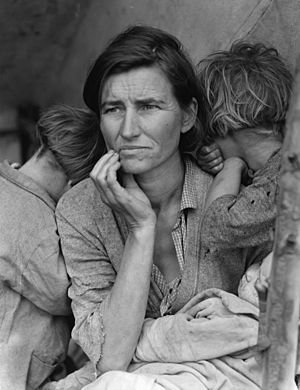Pea-pickers facts for kids

A pea-picker was a term used in a negative way to describe poor migrant workers during the Great Depression. These people often had little education or special skills. They could only find simple jobs, like harvesting crops. Because of this, they earned very little money for working long hours in tough conditions. Some of these workers were photographed by the famous photographer Dorothea Lange.
The term "pea picker" was also used to show that one group of people was seen as a lower social class than another. For example, people might say the "pea-picking" Smiths versus the "respectable" Smiths. Temporary communities where these workers lived were called pea picker camps. Farms that hired them were known as pea-picker farms.
Contents
Life for Migrant Workers
During the Great Depression, many people faced very hard times. Finding work was difficult, and many families struggled to get enough food and shelter. Migrant workers often traveled from place to place, following the harvest seasons to find work. They lived in simple camps, sometimes with poor sanitation and little access to clean water.
What Was the Great Depression?
The Great Depression was a very serious worldwide economic downturn that started in 1929 and lasted through the 1930s. It meant that many people lost their jobs, their savings, and their homes. Businesses closed, and there was widespread poverty. This made it very hard for families to survive, especially those who relied on farming or simple labor.
The Dust Bowl's Impact
The Dust Bowl was a period of severe dust storms and drought in the 1930s. It mainly affected the Great Plains region of the United States. Years of dry weather and poor farming practices turned fertile land into dry dust. Huge dust storms, sometimes called "black blizzards," swept across the land, making it impossible to grow crops.
Why Did People Leave the Dust Bowl?
Because of the Dust Bowl, many families, especially farmers, lost their farms and everything they owned. They had no crops to sell and no way to make a living. With no end to the drought in sight, they packed up their belongings and headed west. Many traveled on Route 66, hoping to find work and a better life in California. They dreamed of finding the "American dream" there.
Mexican Repatriation During the Depression
During the Great Depression, between 1929 and 1939, the American government sent many people of Mexican descent back to Mexico. This event is known as the Mexican Repatriation. It happened because there was a lot of fear about high unemployment rates in the United States. Many people, including American citizens and legal residents, were forced to leave the country without proper legal steps.
Who Were the New Pea-Pickers?
Before the Dust Bowl and the Mexican Repatriation, most of the people who picked peas were from Mexico, the Philippines, or were single white men. But as the new families from the Dust Bowl arrived, they needed work. These new workers were often unskilled and came with their entire families. They took on the tough jobs of harvesting crops, and this new group of workers helped to make the term "pea-pickers" widely used for them.

